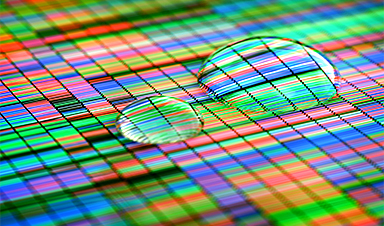The laborious, uneconomical process of sequencing DNA molecules – a technology used to identify, diagnose, and perhaps find treatments for diseases – could become much faster and cheaper thanks to a new nanofabrication technique that exploits nano-sized air-gaps, or nanocracks, in electrically conductive materials.
A doctoral student in Micro and Nanosystems at KTH, Valentin Dubois, presented the new method in his dissertation, explaining that the results offer a potential alternative to existing optical DNA sequencing processes, which depend on bulky, costly equipment. The research was done in partnership with his supervisors.
Our method can, in principle, enable the development of DNA sequencers consisting of a simple USB-connected docking station, in a size equivalent to a small smartphone, costing less than €100. And anyone could use it without any special training. Hopefully, it will be possible to determine a person’s genetic makeup in less than an hour, instead of days, as is the case nowadays. Valentin Dubois
Nanogap electrodes, essentially a pair of electrodes having a nanometer-sized gap between them, are gaining attention as scaffolds to explore, sense, or harness the smallest stable structures located in nature: molecules. In his dissertation Crack-junctions: Linking the gap between nano electronics and giga manufacturing, Valentin Dubois explains how to apply the exceptional properties of nanocracks in electrically conductive materials as a new means of forming electrode pairs possessing nanometer-wide air gaps
Image Credit: Envato/ Alias studio
News This Week
Nano-Enhanced Hydrogel Strategies for Cartilage Repair
A recent article in Engineering describes the development of a protein-based nanocomposite hydrogel designed to deliver two therapeutic agents—dexamethasone (Dex) and kartogenin (KGN)—to support cartilage repair. The hydrogel is engineered to modulate immune responses and promote [...]
New Cancer Drug Blocks Tumors Without Debilitating Side Effects
A new drug targets RAS-PI3Kα pathways without harmful side effects. It was developed using high-performance computing and AI. A new cancer drug candidate, developed through a collaboration between Lawrence Livermore National Laboratory (LLNL), BridgeBio Oncology [...]
Scientists Are Pretty Close to Replicating the First Thing That Ever Lived
For 400 million years, a leading hypothesis claims, Earth was an “RNA World,” meaning that life must’ve first replicated from RNA before the arrival of proteins and DNA. Unfortunately, scientists have failed to find [...]
Why ‘Peniaphobia’ Is Exploding Among Young People (And Why We Should Be Concerned)
An insidious illness is taking hold among a growing proportion of young people. Little known to the general public, peniaphobia—the fear of becoming poor—is gaining ground among teens and young adults. Discover the causes [...]
Team finds flawed data in recent study relevant to coronavirus antiviral development
The COVID pandemic illustrated how urgently we need antiviral medications capable of treating coronavirus infections. To aid this effort, researchers quickly homed in on part of SARS-CoV-2's molecular structure known as the NiRAN domain—an [...]
Drug-Coated Neural Implants Reduce Immune Rejection
Summary: A new study shows that coating neural prosthetic implants with the anti-inflammatory drug dexamethasone helps reduce the body’s immune response and scar tissue formation. This strategy enhances the long-term performance and stability of electrodes [...]
Scientists discover cancer-fighting bacteria that ‘soak up’ forever chemicals in the body
A family of healthy bacteria may help 'soak up' toxic forever chemicals in the body, warding off their cancerous effects. Forever chemicals, also known as PFAS (per- and polyfluoroalkyl substances), are toxic chemicals that [...]
Johns Hopkins Researchers Uncover a New Way To Kill Cancer Cells
A new study reveals that blocking ribosomal RNA production rewires cancer cell behavior and could help treat genetically unstable tumors. Researchers at the Johns Hopkins Kimmel Cancer Center and the Department of Radiation Oncology and Molecular [...]














Leave A Comment